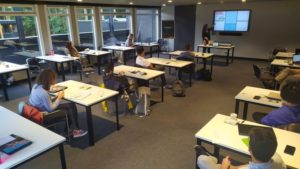NOCI retreat September 24-25, 2020
 One of the most important features of the NOCI consortium is to enable direct interaction with all members from different organ-on-chip related areas. This is enabled by the organization of bi-yearly training and retreats. The retreat organized in September 2020 was somewhat of a unique retreat under the COVID-19 circumstances. So for the first time, a hybrid retreat was organized. Participants could either join in person at the conference hotel “De Werelt” in Lunteren or online via Microsoft teams, enabling a safe and responsible retreat. This was all made possible by a great combined organization effort with the “De Werelt”, who made all necessary measurements to ensure that social distancing could be ensured at all times. With this taken care of, we could focus completely on the full scientific agenda.
One of the most important features of the NOCI consortium is to enable direct interaction with all members from different organ-on-chip related areas. This is enabled by the organization of bi-yearly training and retreats. The retreat organized in September 2020 was somewhat of a unique retreat under the COVID-19 circumstances. So for the first time, a hybrid retreat was organized. Participants could either join in person at the conference hotel “De Werelt” in Lunteren or online via Microsoft teams, enabling a safe and responsible retreat. This was all made possible by a great combined organization effort with the “De Werelt”, who made all necessary measurements to ensure that social distancing could be ensured at all times. With this taken care of, we could focus completely on the full scientific agenda.
Everyone first was updated on the progress of every project using a short discussion-oriented presentation. Another key aspect of this retreat was several brainstorm sessions about the content and direction of a collaborative NOCI literature review. At first, break-out sessions for each specific area of expertise were organized. Together with the virtual attendees, each group drew up focus points of their field. These focus points were discussed and further combined towards a coherent structure throughout the review in a joint discussion. Having these direct discussion has enabled us to set out a solid foundation for future work on this collaborative review in which all sides of our expertise will be combined in one review. The retreat was finalized by a workshop on visual communication by visual design expert Danielle Ceulemans from Sticky Visuals (www.stickyvisuals.nl). Especially in such an interdisciplinary field as organ-on-chips, it is essential to communicate efficiently and effectively your research to others. The workshop gave direct tips and tricks on how to simplify and visualize complex processes. The hands-on part gave everyone time to think about their research project and how to convert it into one schematic visual to make it more memorable and comprehensible to a broad audience.
